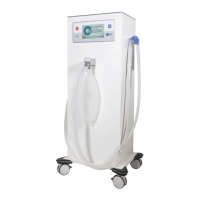– 19 –
trous oxide cylinder for safety reasons. The nitrous oxide
cylinder must be stored upright.
Caution! Before any sedation, always check the
residual pressure in the O
2
cylinder (at least 50 bar
with 10-litre cylinders)! Always keep a spare oxygen
cylinder on hand!
Oxygen ll level calculation:
200 bar gaseous/10-litre O
2
cylinder
Example: The oxygen cylinder pressure gauge
indicates 200 bar (full cylinder)
200 bar working pressure x 10 l (gas cylinder volume)
by 5 l/min. ventilation
If the oxygen cylinder indicates 200 bar, a
treatment of approx. 400 minutes is still possible.
Nitrous oxide ll level calculation:
Nitrous oxide is initially in a liquid state. Pressure drops
are only discernible on
the pressure gauge when it becomes gaseous.
With nitrous oxide, it is dicult to estimate how long
a cylinder will last (10 l cylinder approx. 650 minutes).
~50 bar liquid/10-litre N
2
O cylinder
Example: Pressure drops to 40 bar
-
ume)
Ventilation (50% nitrous oxide)
If the nitrous oxide cylinder indicates 40 bar, a
treatment of approx. 114 minutes is still possible.
To identify the gases, the cylinders are colour-coded
white for O
2
and blue for N
2
O. Alternatively, colour-neu-
tral labelling can also be used.
NOTE: Nitrous oxide: blue, oxygen: white
Both nitrous oxide and oxygen are re accelerants.
CAUTION! -
ly cylinders and pressure reducers, free of oil and
grease to prevent the risk of explosion!
If there is a power outage, administer 100% oxygen to
your patient to discontinue the nitrous oxide sedation
and start the recovery phase. If you do not have any ox-
ygen supply due to the power outage, remove the mask
from the sedated patient and let him exhale the nitrous
oxide through the ambient air. Depending on the nitrous
oxide concentration administered, the patient should
only leave the practice after approx. 30-60 minutes.
6.2 Safety features
Baldus® Touch has the following
safety features:
•Self-test:For the self-test, one gas is sent at a time
across the measurement section. The unit then rec-
ognises whether one or both kinds of gases are not
owing. If one of the two gases is not owing, the unit
immediately indicates this and it indicates visually and
acoustically that the relevant gas is not owing. The
self-test is performed every time the unit is switched
on (from standby mode as well).
•O
2
ush button: 100% oxygen is delivered as long as
the red button is kept pressed.
•Acousticandvisualinformationsignals:Acoustic and
visual information signals
•Recoveryatthepressofabutton:Recovery at the
press of a button
•One-ngertipcontrol:The ow set at the beginning is
not changed by the addition of particular percentages
of N
2
O to the mix. Therefore, the depth of sedation can
be adjusted in just a few steps.
if the breathing bag is empty
to prevent rebreathing
if there is a lack of oxygen
•ConnectorfortheO
2
emergency mask
•Gastypecoding:You can quickly tell which gas is
which from the dierent colour-coding for the gas
types on the pressure hoses and gas cylinders. Please
note that in case of medical gases used in Germany,
nitrous oxide is coded blue and oxygen white. The
connectors are dierent sizes to prevent confusion.

